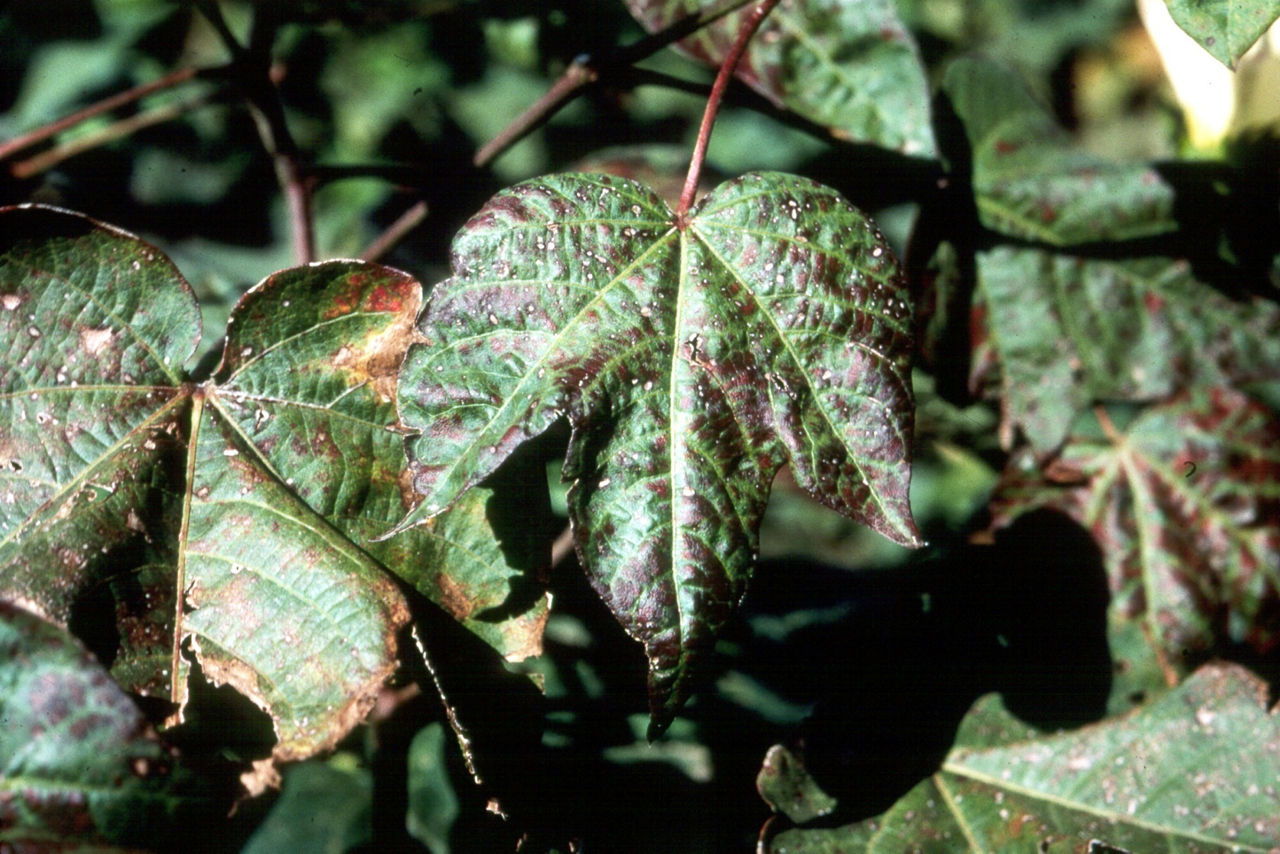5 MIN READ
Low Potassium Reducing Cotton Yield Potential
January 6, 2024
Potassium (K) deficiency has become more widespread across the Cotton Belt and in some areas is the greatest nutrient obstacle for cotton production. Deficiency symptoms are often observed midseason in patches that may be associated with soil type or sandy washes of a field.1 Damaged leaves and poorly developed bolls from inadequate K can reduce fiber quality and yield potential.

Declining Potassium Levels
There are several sources of nutrient loss impacting K levels in the soil. Higher-yielding cotton varieties require more K, which is then depleted when harvested seed cotton is removed from the field.2 Previous crops also impact field K levels. Baling peanut hay can remove 60 lb K/acre,1 and each harvested bushel of soybeans removes 1.25 lb K/acre from the soil.3 A 90-bushel/acre soybean crop removes 112.5 lb K/acre. A 50 bu/acre soybean crop removes 63 lb K/acre. When removed nutrients are not replaced, the following crop is force to “mine” nutrients from the topsoil and subsoil. Under these conditions, the K level in the soil drops, which has a large negative impact on quality and yield potential for a highly K-sensitive crop like cotton.
Potassium Requirements
Potassium plays many critical roles in cotton fiber development, photosynthesis, turgor pressure, and enzyme activation. Potassium is essential for leaf development and pollen tube elongation. Cotton plants with adequate K can also have higher water-use efficiency than K-deficient plants.2 The greatest demand for K in cotton occurs from first bloom to peak bloom, or 50 to 80 days after planting.2 Maximum daily K uptake rates during flowering are 2.2 to 3.5 lb/acre per day.4 Developing cotton bolls are a large K sink as K is essential for fiber quality, including micronaire, length, and strength. Limited K during boll development causes a reduction in turgor pressure of the fiber, less cell elongation, and shorter fibers.

Potassium Deficiency Symptoms and the Link to Stemphylium
Potassium deficiency happens quickly so it is important to recognize symptoms early. Prior to peak bloom, deficiency symptoms can be observed on older leaves as interveinal chlorosis. This progresses into a reddish-gold color (Figure 2) and can be observed with increased foliar disease. Stemphylium leaf spot is linked to K deficiency and can be remedied with increased K availability.1 Plants with Stemphylium leaf spot or K deficiency can drop leaves prematurely and have a reduced boll load.
Early Detection of Potassium Deficiency
Potassium levels can be determined by soil tests, as well as petiole and leaf analysis. Tissue tests are excellent guides for determining fertilizer recommendations during the growing season. To detect K deficiency in cotton, select 30 to 40 of the uppermost main-stem leaf petioles.5 Sampling should occur during early bloom and at the same time of day to avoid moisture variation in sampled leaves. Leaf samples provide nutrient levels experienced by the plants over the past few weeks, while petiole samples provide nutrient levels over the past few days. A drop in K levels in a K-deficient leaf may be greater and easier to detect than a drop in petiole K levels.
Avoiding and Correcting Potassium Deficiencies
Following soil test recommendations, cotton growers should establish and maintain high K levels in the topsoil and the subsoil to adequately supply the nutrient throughout the growing season. Though drought, limited root growth due to nematode damage, heavy early season precipitation, or soil compaction can all result in reduced K uptake even with optimum soil-test K levels. It is recommended to apply all K up front, but sidedress applications can be made while plants are young.
Foliar K applications can be used to supplement soil-applied K. When a potential K deficiency is diagnosed by tissue samples, foliar K applications can help correct the deficiency within 20 hours.4 Growers should be prepared to begin foliar K applications (in the form of potassium nitrate or potassium sulphate) from square initiation through peak boll development. Depending on boll load, three to four foliar applications of 3 lb K/acre should be administered at least a week apart to correct the deficiency.4 Detection of K deficiency requires vigilance, and often leaf tissue testing, to prevent greater yield losses. While not a substitute for a sound soil-fertilization program, foliar K applications can boost K levels during boll development and other critical times during the growing season.
Summary
Potassium deficiency is becoming more widespread across the Cotton Belt. Start with soil sampling, apply the required K at the beginning of the season, and consider two applications of K2O during early flowering (between the first and fourth weeks of bloom).1
Sources
1 Harris, G. 2023. Potassium fertilizer management in cotton. University of Georgia. https://doi.org/10.1094/GROW-COT-01-23-383.
2 Lewis, K., Morgan, G., Frame, W.H., Fromme, D., Dodds, D., Edmisten, K.L., Robertson, B., Boman, R., Cutts, T., Delaney, D.P., Burke, J.A., and Nichols, R.L. 2021. Cotton yield response to soil applied potassium across the U. S. Cotton Belt. Agronomy Journal, 113:4, 3600-3614. https://doi.org/10.1002/agj2.20719.
3 Nutrient requirements – soybean. Iowa State University Extension and Outreach. https://crops.extension.iastate.edu/encyclopedia/nutrient-requirements-soybean.
4 Abaye, A.O. Potassium fertilization of cotton. Virginia Tech. Virginia Cooperative Extension. Publication 418-025. https://www.pubs.ext.vt.edu/418/418-025/418-025.html.
5 Dodds, D. 2016. Potassium deficiency in cotton. Mississippi Crop Situation. Mississippi State University. https://www.mississippi-crops.com/2016/07/15/potassium-deficiency-in-cotton-2/.
1413_140038